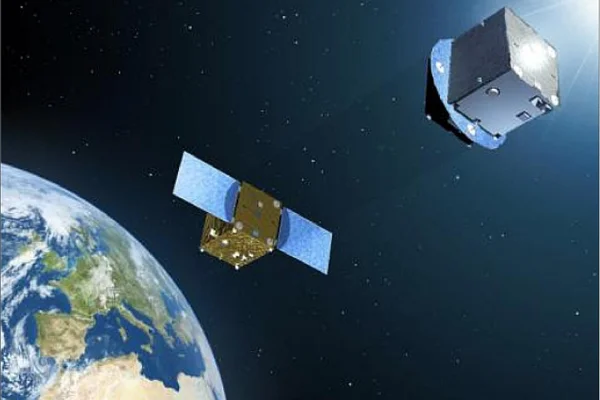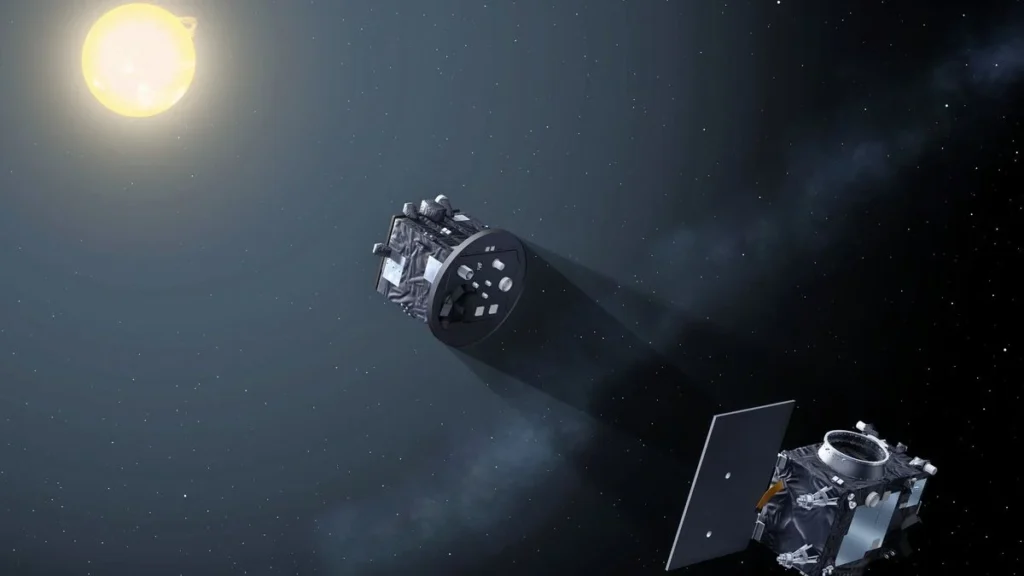India is set to launch the European Space Agency’s (ESA) Proba-3 mission in September 2024.
Proba-3 mission:
- Proba-3 is the world’s first precision formation flying mission, employing a pair of satellites operating as a ‘large rigid structure’ in space to create a solar coronagraph.
- The mission aims to create a 144-meter long solar coronagraph using the aligned satellites, providing scientists with an unprecedented and continuous view of the Sun’s elusive corona.
- Proba-3 mimics an artificial eclipse in space, enabling continuous observation of the corona closer to the solar rim than ever before.
- ESA has developed cutting-edge technologies, including precision cold gas thrusters and vision-based detection systems, crucial for maintaining millimeter-scale accuracy in positioning the two spacecraft.
- The formation flying of Proba-3 serves as a testbed for future multi-satellite missions, providing insights for potential virtual structures in space systems.
- Proba-3’s success opens possibilities for more complex and versatile space systems, potentially revolutionizing Earth observation, telecommunications, and deep-space exploration approaches.
- The mission will be launched using the PSLV-XL rocket, a reliable launch vehicle operated by the Indian Space Research Organisation (ISRO).
How will it mimic an artificial eclipse in space?
- The mission will launch two small satellites that will separate in space and orbit Earth together.
- Similar to a natural solar eclipse where the moon obscures the sun, the two satellites—an occulter and a specialized instrument called a coronagraph—will align 144 meters (472 feet) apart.
- This configuration will mimic a solar eclipse, with the occulter blocking the sun’s glaring disk for the coronagraph.
About Polar Satellite Launch Vehicle (PSLV):
- PSLV is the third generation indigenously-developed expendable launch system of the ISRO (Indian Space Research Organization).
- It is the first Indian launch vehicle to be equipped with liquid stages.
- It comes in the category of medium-lift launchers with a reach up to various orbits, including the Geo Synchronous Transfer Orbit, Lower Earth Orbit, and Polar Sun Synchronous Orbit.
- PSLV achieved its maiden successful launch in October 1994, establishing itself as a reliable and versatile workhorse launch vehicle for India.
- PSLV has launched a multitude of Indian and foreign customer satellites, emphasizing its reliability in satellite deployment.
- PSLV achieved significant milestones by successfully launching two landmark spacecraft – “Chandrayaan-1 in 2008” for lunar exploration and the “Mars Orbiter Spacecraft in 2013” for Martian exploration.
Mechanism:
- PSLV has a four-stage system comprising a combination of solid and liquid-fuelled rocket stages.
- The first stage, at the bottom, is solid-fueled with six strap-on solid rocket boosters.
- The second stage is liquid-fueled, while the third stage utilizes a solid-fueled rocket motor.
- The fourth stage employs liquid propellant for boosting in outer space.
Versions of PSLV:
- In addition to the regular version, the PSLV is utilized in its Core Alone configuration and an XL Version.
- The Core Alone version is launched without six strap-on boosters and less upper stage propellant, designed for missions with small payloads.
- The XL version is launched with extra propellant in the strap-on solid rocket boosters to increase payload capacity.
Ref: Source
| UPSC IAS Preparation Resources | |
| Current Affairs Analysis | Topperspedia |
| GS Shots | Simply Explained |
| Daily Flash Cards | Daily Quiz |



